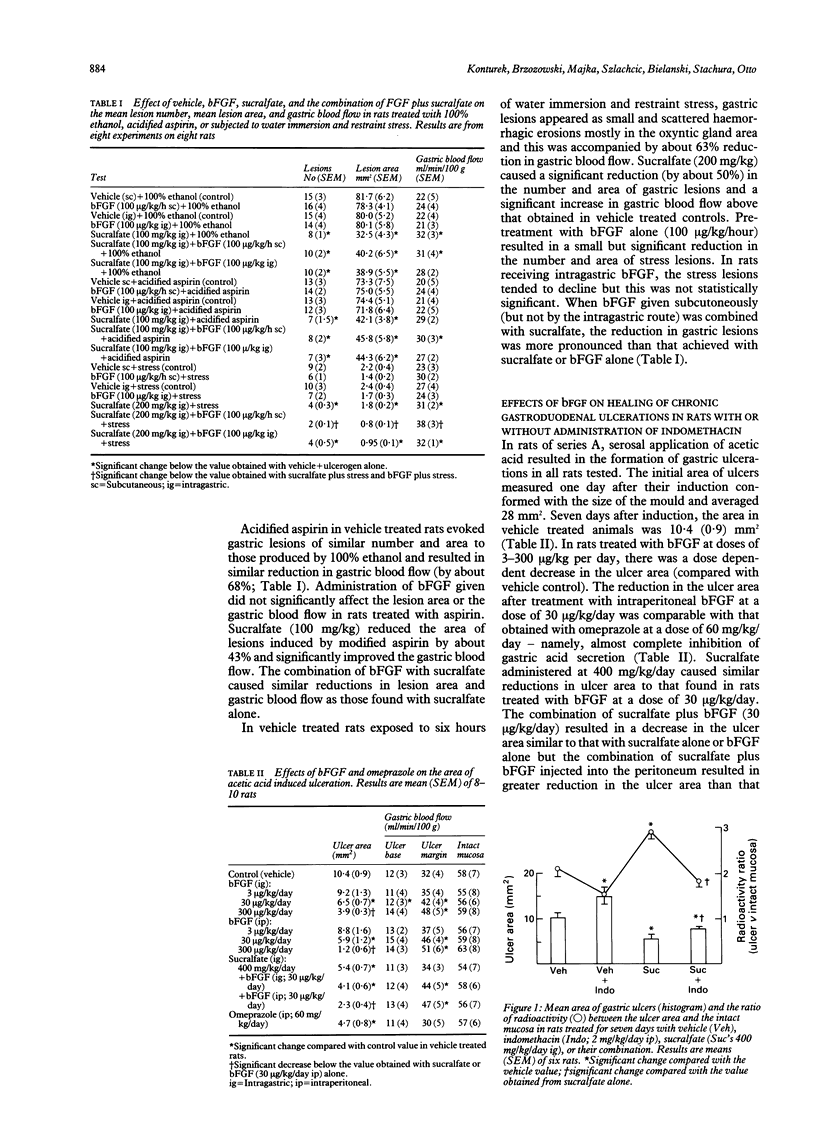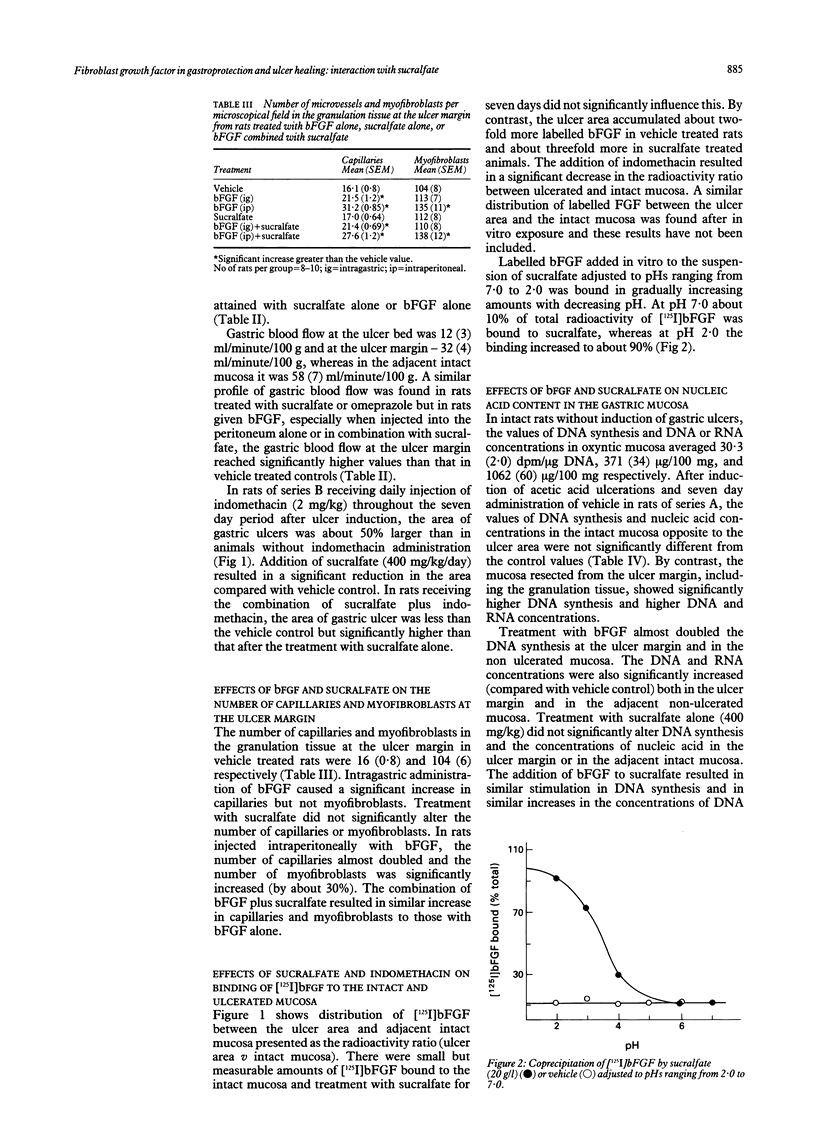Abstract
The study was designed to determine the gastroprotective and ulcer healing efficacy of basic transforming growth factor (bFGF) and to assess whether this peptide contributes to the action of sucralfate on the rat stomach. Application of human recombinant bFGF (1-100 micrograms/kg/hour subcutaneously) failed to affect the formation of acute gastric lesions induced by 100% ethanol and acidified aspirin but reduced the stress induced by gastric lesions. Sucralfate (100-200 mg/kg given orally) protected gastric mucosa against the ethanol, aspirin, and stress induced acute gastric lesions but the addition of bFGF (100 micrograms/kg subcutaneously or intragastrically) failed to affect sucralfate induced protection against ethanol or aspirin but increased that against stress. Administration of bFGF (3-300 micrograms/kg/day) by an intragastric or an intraperitoneal route or sucralfate (400 mg/kg/day) orally to rats with acetic acid induced gastric ulcers, enhanced the healing rate of these ulcers during seven day treatment in a dose dependent manner. This was accompanied by a pronounced increase in the number of capillaries and myofibroblasts and in DNA synthesis and DNA and RNA concentrations in the granulation tissue in the ulcer area. [125I]bFGF (1 microCi) applied subcutaneously or intragastrically accumulated in two to threefold higher amounts in the ulcer area than in the intact mucosa, particularly in rats treated with sucralfate. Concurrent treatment with indomethacin (2 mg/kg intraperitoneally) delayed ulcer healing and reduced the binding of labelled bFGF to the ulcer area, angiogenesis, and DNA synthesis by sucralfate. Addition of [125I]bFGF to sucralfate at various pHs resulted in the coprecipitation of bFGF by sucralfate in a pH dependent manner from about 10% at pH 7.0 to 90% at pH 1.5. Thus bFGF shows little protective activity and is not essential for gastroprotection afforded by sucralfate but plays an important part in healing of gastric ulcers possibly due to its growth promoting and angiogenic actions.
Full text
PDF






Selected References
These references are in PubMed. This may not be the complete list of references from this article.
- Baird A., Esch F., Mormède P., Ueno N., Ling N., Böhlen P., Ying S. Y., Wehrenberg W. B., Guillemin R. Molecular characterization of fibroblast growth factor: distribution and biological activities in various tissues. Recent Prog Horm Res. 1986;42:143–205. doi: 10.1016/b978-0-12-571142-5.50008-2. [DOI] [PubMed] [Google Scholar]
- Baird A., Mormède P., Böhlen P. Immunoreactive fibroblast growth factor in cells of peritoneal exudate suggests its identity with macrophage-derived growth factor. Biochem Biophys Res Commun. 1985 Jan 16;126(1):358–364. doi: 10.1016/0006-291x(85)90614-x. [DOI] [PubMed] [Google Scholar]
- Burgess A. W., Sizeland A. M. Growth factors and the gut. J Gastroenterol Hepatol. 1990;5 (Suppl 1):10–21. doi: 10.1111/j.1440-1746.1990.tb01778.x. [DOI] [PubMed] [Google Scholar]
- Chung S. C., Leung J. W., Leung F. W. Effect of submucosal epinephrine injection on local gastric blood flow. A study using laser Doppler flowmetry and reflectance spectrophotometry. Dig Dis Sci. 1990 Aug;35(8):1008–1011. doi: 10.1007/BF01537250. [DOI] [PubMed] [Google Scholar]
- Cordon-Cardo C., Vlodavsky I., Haimovitz-Friedman A., Hicklin D., Fuks Z. Expression of basic fibroblast growth factor in normal human tissues. Lab Invest. 1990 Dec;63(6):832–840. [PubMed] [Google Scholar]
- Dembiński A., Gregory H., Konturek S. J., Polański M. Trophic action of epidermal growth factor on the pancreas and gastroduodenal mucosa in rats. J Physiol. 1982 Apr;325:35–42. doi: 10.1113/jphysiol.1982.sp014133. [DOI] [PMC free article] [PubMed] [Google Scholar]
- Esch F., Baird A., Ling N., Ueno N., Hill F., Denoroy L., Klepper R., Gospodarowicz D., Böhlen P., Guillemin R. Primary structure of bovine pituitary basic fibroblast growth factor (FGF) and comparison with the amino-terminal sequence of bovine brain acidic FGF. Proc Natl Acad Sci U S A. 1985 Oct;82(19):6507–6511. doi: 10.1073/pnas.82.19.6507. [DOI] [PMC free article] [PubMed] [Google Scholar]
- Folkman J., Klagsbrun M., Sasse J., Wadzinski M., Ingber D., Vlodavsky I. A heparin-binding angiogenic protein--basic fibroblast growth factor--is stored within basement membrane. Am J Pathol. 1988 Feb;130(2):393–400. [PMC free article] [PubMed] [Google Scholar]
- Gospodarowicz D. Fibroblast growth factor. Chemical structure and biologic function. Clin Orthop Relat Res. 1990 Aug;(257):231–248. [PubMed] [Google Scholar]
- Hirose H., Takeuchi K., Okabe S. Effect of indomethacin on gastric mucosal blood flow around acetic acid-induced gastric ulcers in rats. Gastroenterology. 1991 May;100(5 Pt 1):1259–1265. [PubMed] [Google Scholar]
- Hollander D. Efficacy of sucralfate for duodenal ulcers: a multicenter, double-blind trial. J Clin Gastroenterol. 1981;3(Suppl 2):153–157. [PubMed] [Google Scholar]
- Hui W. M., Chen B. W., Cho C. H., Luk C. T., Lam S. K. Role of gastric mucosal blood flow in cytoprotection. Digestion. 1991;48(2):113–120. doi: 10.1159/000200681. [DOI] [PubMed] [Google Scholar]
- Konturek S. J., Brozozowski T., Bielanski W., Warzecha Z., Drozdowicz D. Epidermal growth factor in the gastroprotective and ulcer-healing actions of sucralfate in rats. Am J Med. 1989 Jun 9;86(6A):32–37. doi: 10.1016/0002-9343(89)90154-x. [DOI] [PubMed] [Google Scholar]
- Konturek S. J., Brzozowski T., Drozdowicz D., Dembinski A., Nauert C. Healing of chronic gastroduodenal ulcerations by antacids. Role of prostaglandins and epidermal growth factor. Dig Dis Sci. 1990 Sep;35(9):1121–1129. doi: 10.1007/BF01537585. [DOI] [PubMed] [Google Scholar]
- Konturek S. J., Brzozowski T., Majka J., Czarnobilski K. Role of nitric oxide and prostaglandins in sucralfate-induced gastroprotection. Eur J Pharmacol. 1992 Feb 11;211(2):277–279. doi: 10.1016/0014-2999(92)90541-b. [DOI] [PubMed] [Google Scholar]
- Konturek S. J., Radecki T., Brzozowski T., Piastucki I., Dembiński A., Dembińska-Kieć A., Zmuda A., Gryglewski R., Gregory H. Gastric cytoprotection by epidermal growth factor. Role of endogenous prostaglandins and DNA synthesis. Gastroenterology. 1981 Sep;81(3):438–443. [PubMed] [Google Scholar]
- Konturek S. J. Role of growth factors in gastroduodenal protection and healing of peptic ulcers. Gastroenterol Clin North Am. 1990 Mar;19(1):41–65. [PubMed] [Google Scholar]
- Konturek S. J., Stachura J., Radecki T., Drozdowicz D., Brzozowski T. Cytoprotective and ulcer healing properties of prostaglandin E2, colloidal bismuth and sucralfate in rats. Digestion. 1987;38(2):103–113. doi: 10.1159/000199579. [DOI] [PubMed] [Google Scholar]
- Konturek S. J., Stachura J., Radecki T., Drozdowicz D., Brzozowski T. Cytoprotective and ulcer healing properties of prostaglandin E2, colloidal bismuth and sucralfate in rats. Digestion. 1987;38(2):103–113. doi: 10.1159/000199579. [DOI] [PubMed] [Google Scholar]
- McHardy G. G. A multicenter, double-blind trial of sucralfate and placebo in duodenal ulcer. J Clin Gastroenterol. 1981;3(Suppl 2):147–152. [PubMed] [Google Scholar]
- Nagashima R. Mechanisms of action of sucralfate. J Clin Gastroenterol. 1981;3(Suppl 2):117–127. [PubMed] [Google Scholar]
- Nexø E., Poulsen S. S. Does epidermal growth factor play a role in the action of sucralfate? Scand J Gastroenterol Suppl. 1987;127:45–49. doi: 10.3109/00365528709090950. [DOI] [PubMed] [Google Scholar]
- Olsen P. S., Poulsen S. S., Kirkegaard P., Nexø E. Role of submandibular saliva and epidermal growth factor in gastric cytoprotection. Gastroenterology. 1984 Jul;87(1):103–108. [PubMed] [Google Scholar]
- Polk W. H., Jr, Dempsey P. J., Russell W. E., Brown P. I., Beauchamp R. D., Barnard J. A., Coffey R. J., Jr Increased production of transforming growth factor alpha following acute gastric injury. Gastroenterology. 1992 May;102(5):1467–1474. doi: 10.1016/0016-5085(92)91703-7. [DOI] [PubMed] [Google Scholar]
- Schweigerer L., Neufeld G., Friedman J., Abraham J. A., Fiddes J. C., Gospodarowicz D. Capillary endothelial cells express basic fibroblast growth factor, a mitogen that promotes their own growth. Nature. 1987 Jan 15;325(6101):257–259. doi: 10.1038/325257a0. [DOI] [PubMed] [Google Scholar]
- Takagi K., Okabe S., Saziki R. A new method for the production of chronic gastric ulcer in rats and the effect of several drugs on its healing. Jpn J Pharmacol. 1969 Sep;19(3):418–426. doi: 10.1254/jjp.19.418. [DOI] [PubMed] [Google Scholar]
- Tarnawski A., Hollander D., Stachura J., Krause W. J., Eltorai M., Dabros W., Gergely H. Vascular and microvascular changes--key factors in the development of acetic acid-induced gastric ulcers in rats. J Clin Gastroenterol. 1990;12 (Suppl 1):S148–S157. doi: 10.1097/00004836-199001001-00025. [DOI] [PubMed] [Google Scholar]
- Vlodavsky I., Folkman J., Sullivan R., Fridman R., Ishai-Michaeli R., Sasse J., Klagsbrun M. Endothelial cell-derived basic fibroblast growth factor: synthesis and deposition into subendothelial extracellular matrix. Proc Natl Acad Sci U S A. 1987 Apr;84(8):2292–2296. doi: 10.1073/pnas.84.8.2292. [DOI] [PMC free article] [PubMed] [Google Scholar]
- Wang J. Y., Nagai H., Okabe S. Effect of omeprazole on delayed healing of acetic acid-induced gastric ulcers in rats. Jpn J Pharmacol. 1990 Sep;54(1):82–85. doi: 10.1254/jjp.54.82. [DOI] [PubMed] [Google Scholar]


